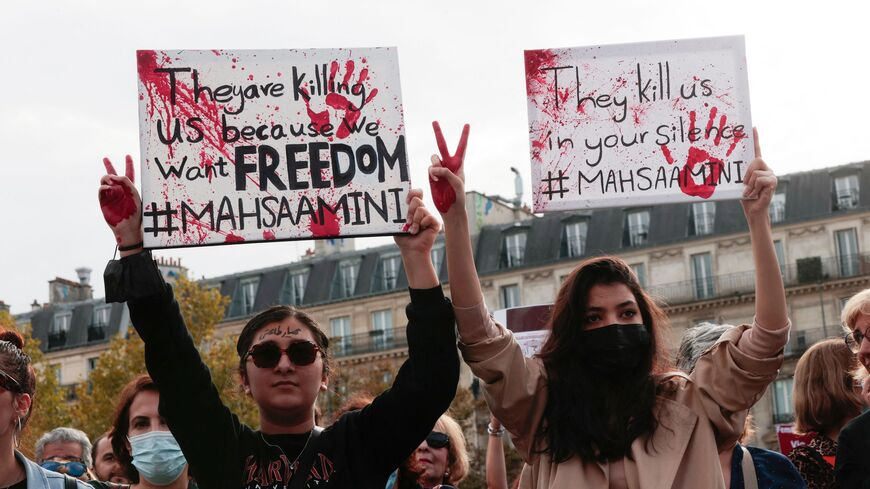
Despite the warning, the protests swelled, and faced an escalation in violent police raids on funerals, campuses and dormitories.
As anti-government unrest entered a seventh week in Iran, the commander of the country’s hard-line Islamic Revolutionary Guard Corps (IRGC) warned protesters to go home.
“Today is the last day of the riots, stop taking to streets,” Maj. Gen. Hossein Salami declared at a funeral ceremony for victims of a terror attack in the city of Shiraz earlier this week. The shooting claimed by the Islamic State killed 15 people in the midst of the protests that were triggered by the death of 22-year-old Mahsa Amini in custody of religious police in mid-September.
“These plots are old, the IRGC is the same as Daesh,” protesters shouted from multiple locations on Saturday, using the Arabic acronym for the Islamic State, and to dismiss the government’s narrative about the Shiraz attack. The Iranian authorities have been linking the violence to security lapses caused by the protests, while opponents allege that the state intentionally allowed lax security into the site of the attack to exploit it as “propaganda” against the protesters.
The IRGC commander had already announced an end to the ongoing protests in an Oct. 20 speech, describing them as “a stillborn baby.” Similarly, the chief of the Iranian riot police unit declared last month that the unrest had completely fizzled out, “because our forces do have the expertise to wrap up such issues in a matter of few days.”
According to the Oslo-based Iran Human Rights organization, the Islamic Republic’s security forces have killed at least 253 protesters, including 34 minors and 19 women, in the crackdown. Iranian authorities deny the charge, linking some of the controversial deaths to suicides, health issues and other causes unrelated to the protests. In the latest, Tehran’s police authorities said the case of a medical doctor, who was reported to have been killed following injuries she sustained during a Wednesday protest by medics, had died in a “car accident.”
‘A CIA job’
An exact count on the arrests also remains unavailable, but estimates by right groups have gone up to 13,000. The first trial for a group of the detained protesters was held in Tehran on Saturday, where five defendants were formally charged with “corruption on earth” and “waging war on God,” both punishable by the death penalty under Iran’s judicial laws.
Dozens of journalist are also among those arrested, including Niloufar Hamedi, who originally scratched the surface on Mahsa Amini’s death. The IRGC’s intelligence organization and the Intelligence Ministry issued a lengthy 30-page joint statement on Friday, elaborating on their assessment of how Iran’s “enemies” had fomented the unrest. Most notably, the report accused Hamedi of working for the US Central Intelligence Agency (CIA), claiming she had received “regime change” training by the spy organization. Mehdi Rahmanian, the editor of the Shargh Reformist daily, for which Hamedi covered the story, has strongly rejected the allegations, saying she had simply fulfilled her journalistic responsibility.
Intensifying crackdown
The IRGC commander’s speech fueled fears that the hard-line force, with a history of iron-first responses to previous protests, will be increasingly engaged to unleash yet a harsher crackdown.
Hours into Salami’s warning, protests gathered renewed pace in over a dozen cities, and so did the security measures.
An upsurge in attacks on university campuses and dormitories was particularly notable. In videos verified by the Kurdish Hengaw rights organization, security forces stormed a medical university in the western city of Sanandaj, opening fire on protesting students. Similar scenes were reported at Tehran University’s Faculty of Engineering, while a university in Mashhad was apparently under siege by plainclothes forces, who pushed back on outsiders attempting to rescue the students. And in what appeared to be violent raids on dormitories in Ahvaz, Sanandaj, Mashhad and Tehran, IRGC intelligence agents were tasing and dragging students on floors before forcefully bundling them into security vehicles.
Also on Saturday, funerals for new victims or in memory of others killed earlier on, were held in such cities as Saghez, Sardasht, Kermanshah and Arak, where thousands of mourners chanted for the overthrow of the Islamic Republic and vowed revenge for their “brothers and sisters”. Videos released by activists from some of those events showed police and paramilitary Basij militia severely beating and teargassing the mourners.
“As days go by, I barely feel any relief,” said the daughter of 55-year-old woman Minou Majidi in an address from London to protesters in Kermanshah, who were marking 40 days into her mother’s death. “The tyranny that has been committed against us is only flaring up the rage within me.”
